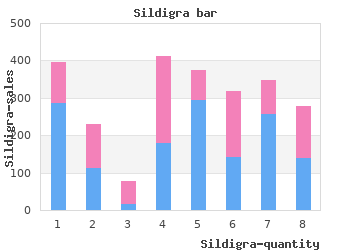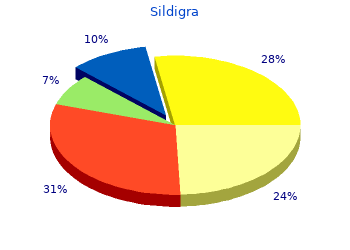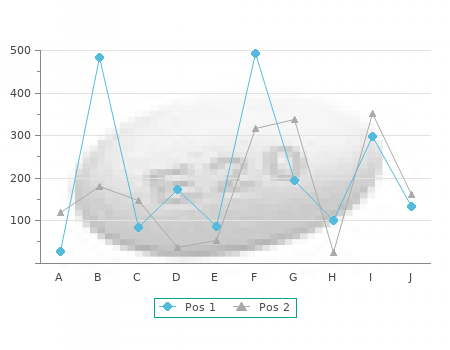Sildigra
2018, Thomas Cooley Law School, Gunock's review: "Sildigra 120 mg, 100 mg, 50 mg, 25 mg. Only $0,59 per pill. Buy online Sildigra no RX.".
Methylphenidate effects on functional outcomes in the Preschoolers with Attention-Deficit/Hyperactivity Disorder Treatment Study (PATS) purchase sildigra 50mg overnight delivery. Effectiveness of methylphenidate in the 10- month continuation phase of the Preschoolers with ADHD Treatment Study (PATS). Fitzpatrick PA, Klorman R, Brumaghim JT, Borgstedt AD. Effects of sustained-release and standard preparations of methylphenidate on attention deficit disorder. Journal of the American Academy of Child & Adolescent Psychiatry. Sustained release and standard methylphenidate effects on cognitive and social behavior in children with attention deficit disorder. Once-a-day Concerta methylphenidate versus three-times-daily methylphenidate in laboratory and natural settings. Randomized, controlled trial of OROS methylphenidate once a day in children with attention-deficit/hyperactivity disorder. Comparison of sustained-release and standard methylphenidate in the treatment of minimal brain dysfunction. Relative efficacy of long- acting stimulants on children with attention deficit-hyperactivity disorder: a comparison of standard methylphenidate, sustained-release methylphenidate, sustained-release dextroamphetamine, and pemoline. Comparative efficacy of once-a-day extended-release methylphenidate, two-times-daily immediate-release methylphenidate, and placebo in a laboratory school setting. Greenhill, Laurence L (Ed); Osman, Betty B (Ed) (1991) Ritalin: Theory and patient management (pp 223-231) 338pp. Findling RL, Quinn D, Hatch SJ, Cameron SJ, DeCory HH, McDowell M. Comparison of the clinical efficacy of twice-daily Ritalin and once-daily Equasym XL with placebo in children with Attention Deficit/Hyperactivity Disorder. Attention deficit hyperactivity disorder 126 of 200 Final Update 4 Report Drug Effectiveness Review Project 48. An open-label, randomized, active- controlled equivalent trial of osmotic release oral system methylphenidate in children with attention-deficit/hyperactivity disorder in Taiwan. Steele M, Weiss M, Swanson J, Wang J, Prinzo RS, Binder CE. A randomized, controlled effectiveness trial of OROS-methylphenidate compared to usual care with immediate-release methylphenidate in attention deficit-hyperactivity disorder. Canadian Journal of Clinical Pharmacology/Journal Canadien de Pharmacologie Clinique. Development of a new once-a-day formulation of methylphenidate for the treatment of attention-deficit/hyperactivity disorder: proof-of- concept and proof-of-product studies. New pharmaceutical forms: a slight advantage for a small number of children. Switching from immediate- to sustained- release psychostimulants in routine treatment of children with attention-deficit hyperactivity disorder. Cognitive and behavioral effects of multilayer- release methylphenidate in the treatment of children with attention-deficit/hyperactivity disorder. Once-daily multilayer-release methylphenidate in a double-blind, crossover comparison to immediate-release methylphenidate in children with attention-deficit/hyperactivity disorder. Continuity of Methylphenidate Treatment for Attention-Deficit/Hyperactivity Disorder. Effect of methylphenidate formulation for attention deficit hyperactivity disorder on patterns and outcomes of treatment. Effect of methylphenidate formulation on treatment patterns and use of emergency room services. Impact of methylphenidate formulation on treatment patterns and hospitalizations: a retrospective analysis. Continuity in methylphenidate treatment of adults with attention-deficit/hyperactivity disorder. Sanchez RJ, Crismon ML, Barner JC, Bettinger T, Wilson JP. Assessment of adherence measures with different stimulants among children and adolescents. Sonuga-Barke EJ, Swanson JM, Coghill D, DeCory HH, Hatch SJ. Efficacy of two once- daily methylphenidate formulations compared across dose levels at different times of the Attention deficit hyperactivity disorder 127 of 200 Final Update 4 Report Drug Effectiveness Review Project day: preliminary indications from a secondary analysis of the COMACS study data. A comparison of once-daily extended-release methylphenidate formulations in children with attention-deficit/hyperactivity disorder in the laboratory school (the COMACS Study). Comparative efficacy of two once daily methylphenidate formulations (Ritalin LA and Concerta) and placebo in children with attention deficit hyperactivity disorder across the school day. Silva R, Muniz R, Pestreich LK, Brams M, Childress A, Lopez FA.

Chronic hepatitis C can lead to a membranoproliferative GN order 50mg sildigra visa, or through cryoglobulinemia cause vasculitis with renal involvement. The most common form of renal disease in Germany is IgA nephropathy, which can also be triggered by HIV, respiratory infections or infection with hepatitis. With post- infectious GN, the underlying infection is treated first, and is then monitored so that the necessity of a possible additional immunosuppression can be deliberated between nephrologist and HIV specialist. Irrespective of the liver histology, HCV-associated HIV and Renal Function 577 GN can also be a reason for therapy, especially in cases of cryoglobulinemia-associ- ated vasculitis (observe dosing interval adjustments). However, only a greatly reduced dose or no ribavirin at all should be used if the creatinine clearance is less than 50 ml/min/1. For example, an alternating daily dose of 200 and 400 mg should be administered. In untreated HIV+ patients, hemolytic-uremic syndrome (HUS) or thrombotic- thrombocytopenic microangiopathy syndrome (TTP) can occur, characterized by the combination of creatinine increase, signs of hemolysis (increased LDH, thrombope- nia) and neurological symptoms with kidney failure. Pathophysiologically, the induc- tion of procoagulatory effects of gp120 (HIV) on endothelial cells can probably be assumed (Mikulak 2010). In these cases, plasma separation or a therapy with immunoabsorption is necessary, in order to improve the otherwise bad prognosis and to prevent dialysis. Principles of therapy of glomerulonephritis The underlying cause of all forms of post-infectious glomerulonephritis should be treated first, including HBV, HCV and HIV infection. Kidney failure caused by han- tavirus (transmitted through mouse or rat droppings) has a positive prognosis in Europe and thus its spontaneous course is to be expected. Particular attention should be paid to the adjustment of blood pressure. Target values are <140/80 mmHg or, in the presence of proteinuria, <130/80 mmHg. ACE inhibitors as well as AT-II receptor antagonists are used to control blood pressure, usually in combination with diuretics. Proteinuria should be treated with an ACE inhibitor, at high doses if necessary, irre- spective of the blood pressure measurement, and should be combined additionally with AT-II receptor antagonists if the proteinuria is more than 0. Not smoking is of vital importance because nicotine causes an increase in the risk of progression of glomerulonephritis. Hyperlipidemia should be treated after dietary arrangements have been exhausted. HMG-CoA reductase inhibitors are ideal, provided that they are combined with anti- retroviral therapy (see chapter on Drug Interactions). Fibrates or fibrates plus statins may only be used carefully when renal function is reduced. Analgesics should be avoided as much as possible, especially the “small” analgesics such as ASA and parac- etamol. If creatinine clearance reaches a value of less than 50 ml/min/1. Practical treatment of hypertension in HIV Antihypertensive drugs offer an array of side effects, including hyperkalemia with ACE inhibitors. Reactions can be humoral or T cell-medi- ated and can lead to renal insufficiency. Any change of treatment should always be followed by a check of renal function after 14 days in case of any noticeable renal changes, then every 4-6 weeks in the first year, espe- cially with TDF. Acute renal failure or acute tubular necrosis can also occur during treatment with acyclovir, gancyclovir, adefovir, aminoglycosides or pentamidine. Tubular dysfunc- tion may also occur with ddI, d4T or 3TC. An acute allergic interstitial nephritis can arise in connection with a hypersensitivity reaction when taking abacavir. In patients taking atazanavir and T-20, membranoproliferative GN has been observed. Ritonavir and efavirenz can also cause kidney damage (Winston 2008). A number of specific renal damage toxicities should be addressed individually: Renal side effects of antiretroviral therapy Crystal-associated nephropathy Renal problems due to crystalluria and nephrolithiasis that have seen mainly with indinavir have become rarer with newer PIs. Many medications can cause crystal- luria and it is often a combination of agents that leads to nephrolithiasis. These agents include ampicillin, acyclovir, aspirin, ciprofloxacin, methotrexate, vitamin C, sulfonamide and other drugs that lead to an increase in uric acid. Forced fluid intake, Buscopan and analgesics often lead to resolving acute renal colic without the need for hospitalization. Should it become necessary to consult a urologist, the risks involved in using contrast medium must be clarified. Elevation of creatinine with long-term indinavir therapy was often seen in the late 1990s (Fellay 2001, Boubaker 2001). Typical signs of indinavir nephropathy include sterile leukocyturia with loss of renal function (Gagnon 2000, Dielemann 2003) and an echogenic transformation of the renal parenchyma in otherwise normal kidneys. Discontinuing indinavir leads to normal function in most cases.

Efficacy of B-cell-targeted therapy with rituximab in patients with rheumatoid arthritis safe 25 mg sildigra. Targeted immune modulators 124 of 195 Final Update 3 Report Drug Effectiveness Review Project 129. Sustained benefit in rheumatoid arthritis following one course of rituximab: improvements in physical function over 2 years. Emery P, Fleischmann R, Filipowicz-Sosnowska A, et al. The efficacy and safety of rituximab in patients with active rheumatoid arthritis despite methotrexate treatment: Results of a phase IIB randomized, double-blind, placebo-controlled, dose-ranging trial. Improved health-related quality of life for patients with active rheumatoid arthritis receiving rituximab: Results of the Dose- Ranging Assessment: International Clinical Evaluation of Rituximab in Rheumatoid Arthritis (DANCER) Trial. Rituximab inhibits structural joint damage in patients with rheumatoid arthritis with an inadequate response to tumour necrosis factor inhibitor therapies. Improvement in patient-reported outcomes in a rituximab trial in patients with severe rheumatoid arthritis refractory to anti-tumor necrosis factor therapy. Rituximab for rheumatoid arthritis refractory to anti-tumor necrosis factor therapy: Results of a multicenter, randomized, double-blind, placebo-controlled, phase III trial evaluating primary efficacy and safety at twenty-four weeks. Treatment of rheumatoid arthritis with humanized antiinterleukin6 receptor antibody: a multicenter, doubleblind, placebocontrolled trial. Double-blind randomized controlled clinical trial of the interleukin-6 receptor antagonist, tocilizumab, in European patients with rheumatoid arthritis who had an incomplete response to methotrexate. IL-6 receptor inhibition with tocilizumab improves treatment outcomes in patients with rheumatoid arthritis refractory to anti-tumour necrosis factor biologicals: results from a 24-week multicentre randomised placebo- controlled trial. Interleukin-6 receptor inhibition with tocilizumab reduces disease activity in rheumatoid arthritis with inadequate response to disease-modifying antirheumatic drugs: the tocilizumab in combination with traditional disease-modifying antirheumatic drug therapy study. Effect of interleukin-6 receptor inhibition with tocilizumab in patients with rheumatoid arthritis (OPTION study): a double-blind, placebo-controlled, randomised trial. Targeted immune modulators 125 of 195 Final Update 3 Report Drug Effectiveness Review Project 141. Study of active controlled monotherapy used for rheumatoid arthritis, an IL-6 inhibitor (SAMURAI): evidence of clinical and radiographic benefit from an x ray reader-blinded randomised controlled trial of tocilizumab. Study of active controlled tocilizumab monotherapy for rheumatoid arthritis patients with an inadequate response to methotrexate (SATORI): significant reduction in disease activity and serum vascular endothelial growth factor by IL-6 receptor inhibition therapy. Secondary failure to treatment with recombinant human IL-1 receptor antagonist in Chinese patients with rheumatoid arthritis. Effect of certolizumab pegol with methotrexate on home and work place productivity and social activities in patients with active rheumatoid arthritis. Wiens A, Correr CJ, Pontarolo R, Venson R, Quinalha JV, Otuki MF. A systematic review and meta-analysis of the efficacy and safety of etanercept for treating rheumatoid arthritis. The effectiveness of infliximab and etanercept for the treatment of rheumatoid arthritis: a systematic review and economic evaluation. Infliximab for the treatment of rheumatoid arthritis. The addition of tocilizumab to DMARD therapy for rheumatoid arthritis: a meta-analysis of randomized controlled trials. Abatacept in children with juvenile idiopathic arthritis: a randomised, double-blind, placebo-controlled withdrawal trial. Abatacept improves health-related quality of life, pain, sleep quality, and daily participation in subjects with juvenile idiopathic arthritis. Adalimumab with or without methotrexate in juvenile rheumatoid arthritis. Etanercept in children with polyarticular juvenile rheumatoid arthritis. A randomized, placebo-controlled trial of infliximab plus methotrexate for the treatment of polyarticular-course juvenile rheumatoid arthritis. Efficacy and safety of tocilizumab in patients with systemic-onset juvenile idiopathic arthritis: a randomised, double-blind, placebo- controlled, withdrawal phase III trial. Targeted immune modulators 126 of 195 Final Update 3 Report Drug Effectiveness Review Project 156. The German etanercept registry for treatment of juvenile idiopathic arthritis. Adalimumab, etanercept and infliximab for the treatment of ankylosing spondylitis: a systematic review and economic evaluation. Double-blind placebo-controlled trial of etanercept in the prevention of work disability in ankylosing spondylitis. Efficacy of etanercept on rheumatic signs and pulmonary function tests in advanced ankylosing spondylitis: results of a randomised double-blind placebo-controlled study (SPINE). Efficacy and safety of golimumab in patients with ankylosing spondylitis: results of a randomized, double-blind, placebo-controlled, phase III trial.

Comparison of Ondansetron 25 mg sildigra visa, Tropisetron, Granisetron and Droperidol for prevention of PONV after gyneocological laparoscopy in patients receiving TIVA with 1 Remifentanyl and Propofol. Active control trials On the relationship between nausea and vomiting in patients undergoing chemotherapy. A randomized double-blind trial to compare the clinical efficacy of granisetron with metoclopramide, both combined with dexamethasone in the prophylaxis 2 of chemotherapy-induced delayed emesis. Dolasetron decreases postoperative nausea and vomiting after breast surgery. The prophylaxis of postoperative nausea and vomiting after laparoscopic cholecystectomy. Comparative evaluation of the clinical efficacy and safety of ondansetron and metoclopramide in the prophylaxis of emesis induced by cancer chemotherapy regimens including 2 cisplatin. Agarwal A, Bose N, Gaur A, Singh U, Gupta MK, Singh D. Acupressure and ondansetron for postoperative nausea and vomiting after laparoscopic 2 cholecystectomy. Randomized, placebo-controlled trial of combination antiemetic prophylaxis for day-case gynaecological laparoscopic 2 surgery. A randomized double- blind trial of ondansetron alone versus in combination with dexamethasone versus in combination with dexamethasone and lorazepam in the prevention 2 of emesis due to cisplatin-based chemotherapy. Antiemetics Page 87 of 136 Final Report Update 1 Drug Effectiveness Review Project Exclusion Excluded Studies code # Aksoylar S, Akman SA, Ozgenc F, Kansoy S. Comparison of tropisetron and granisetron in the control of nausea and vomiting in children receiving 2 combined cancer chemotherapy. Comparison of ondansetron, metoclopramide and placebo as premedicants to reduce nausea and vomiting after major surgery. Comparison of ondansetron and droperidol in reducing postoperative nausea and vomiting associated 2 with patient-controlled analgesia. Comparative efficacy of a single oral dose of ondansetron and of buspirone against cisplatin-induced emesis in cancer 2 patients. Alkaissi A, Gunnarsson H, Johnsson V, Evertsson K, Ofenbartl L, Kalman S. Disturbing post-operative symptoms are not reduced by prophylactic 2 antiemetic treatment in patients at high risk of post-operative nausea and vomiting. Ondansetron in the treatment of postoperative vomiting: A randomized, double-blind comparison with droperidol and 2 metoclopramide. Randomized trial to compare the effect of ondansetron versus metopromide plus dexamethasone in controlling delayed 2 emesis after high-dose cisplatin. Persistence of efficacy of three antiemetic regimens and prognostic factors in patients undergoing moderately emetogenic 2 chemotherapy. Delayed emesis induced by moderately emetogenic chemotherapy: do we need to treat all patients? Ondansetron versus metoclopramide, both combined with dexamethasone, in the prevention of cisplatin-induced delayed emesis. An international multicenter protocol to assess the single and combined benefits of antiemetic interventions in a 2 controlled clinical trial of a 2x2x2x2x2x2 factorial design (IMPACT). A factorial trial of six interventions for the prevention of postoperative nausea and vomiting. Antiemetics Page 88 of 136 Final Report Update 1 Drug Effectiveness Review Project Exclusion Excluded Studies code # Arechevala E, Aulitzky W, Boeckmann W, Butcher ME, Dearnaley DP, Droz JP. A randomised, double-blind comparative study of ondansetron (OND) plus dexamethasone (DEX) with metoclopramide (MCP) plus dex as anti- 2 emetic prophylaxis during multi-day cisplatin chemotherapy. Tropisetron vs ondansetron for prevention of postoperative nausea and vomiting after laparoscopic 2 cholecystectomy: A randomized double-blind, placebo-controlled study. Ascaso FJ, Ayala I, Carbonell P, Castro FJ, Palomar A. Prophylactic intravenous ondansetron in patients undergoing cataract extraction under 2 general anesthesia. Badaoui R, Pouilly A, Yagoubi A, Carpentier F, Riboulot M, Ossart M. Comparison of ondansetron and droperidol in the prevention of postoperative 2 nausea and vomiting. Ondansetron (OND) vs metoclopramide (MTC) both combined with dexamethasone (DEX) in the prevention of 2 cisplatin (CDDP)-induced delayed emesis. Cisplatin-induced delayed emesis: Pattern and prognostic factors during three subsequent cycles. Comparison of ondansetron with metoclopramide in prevention of acute emesis associated with low dose & 2 high dose cisplatin chemotherapy. Randomized cross-over trial of ondansetron (OND) and metoclopramide (MET) in the treatment of emesis induced by 2 chemotherapy. Randomized study comparing the efficacy of ondansetron and metoclopramide in the control of emesi induced by 2 chemotherapy. A randomized double-blind comparison of ondansetron and metoclopramide in the prophylaxis of emesis 2 induced by cyclophosphamide, fluorouracil, and doxorubucin or epirubicin chemotherapy.
8 of 10 - Review by H. Amul
Votes: 320 votes
Total customer reviews: 320

